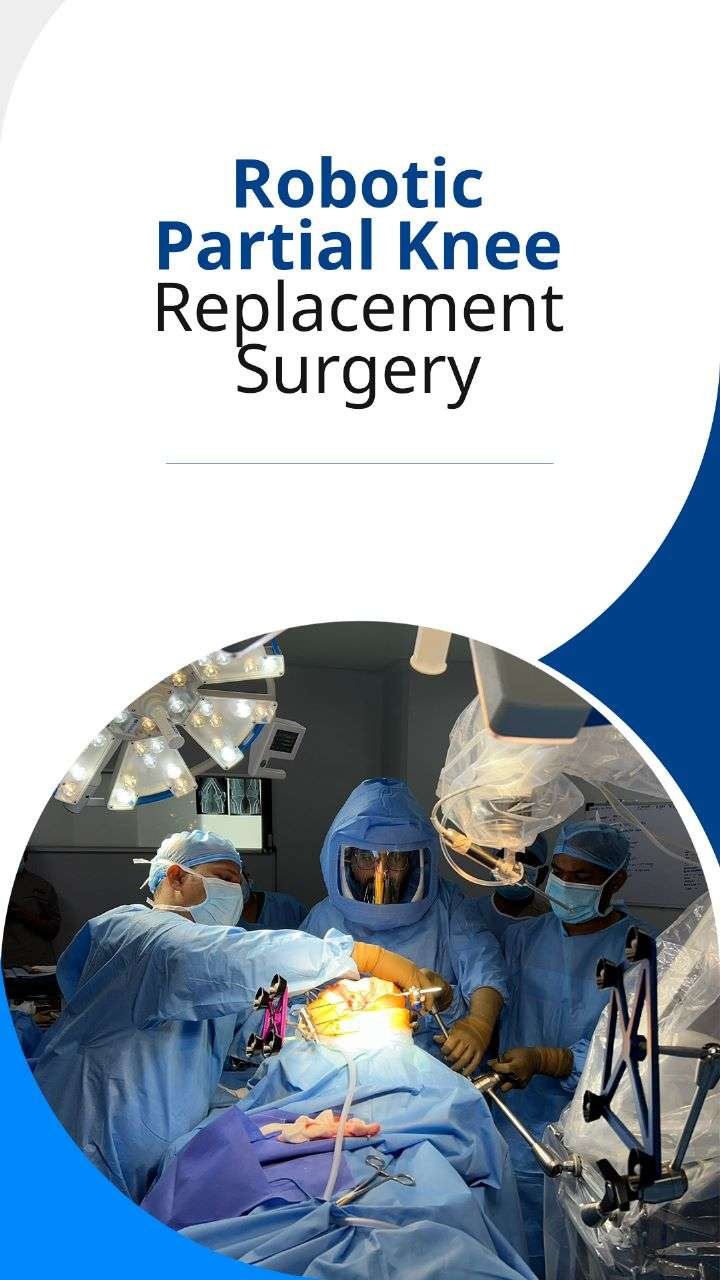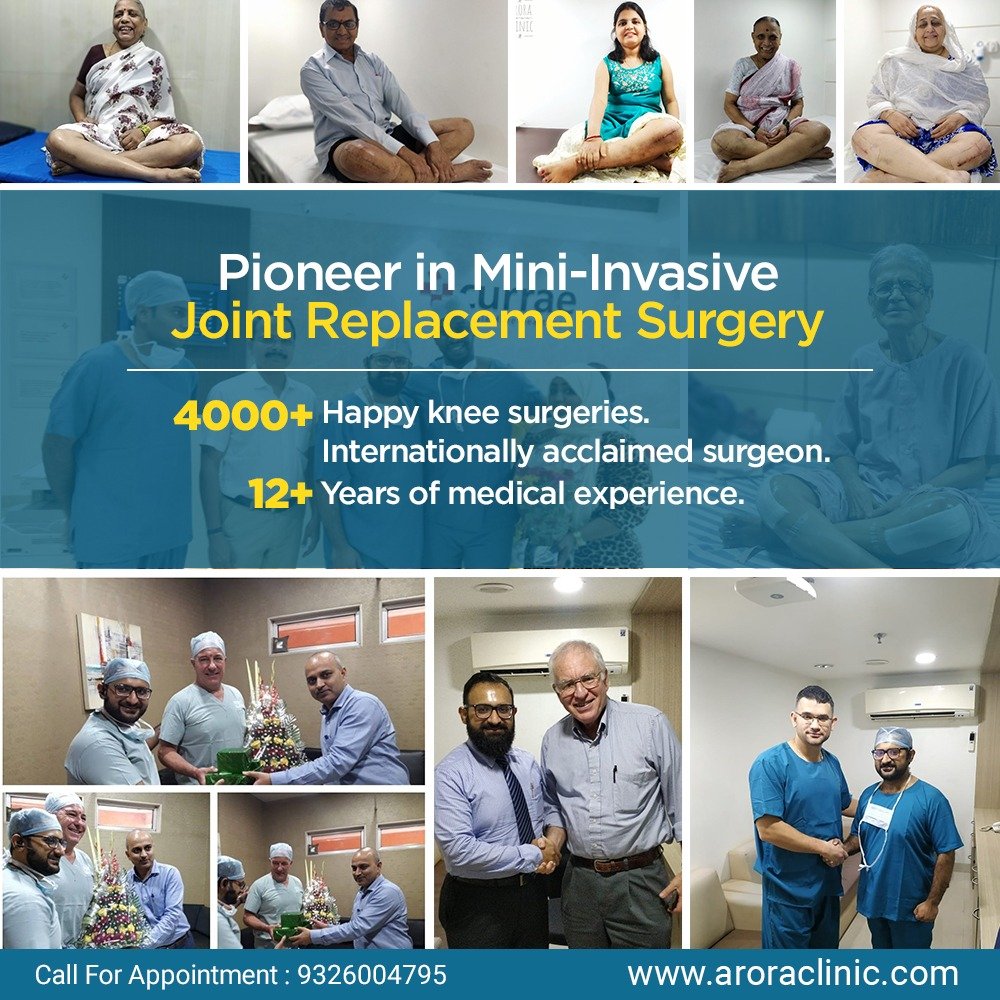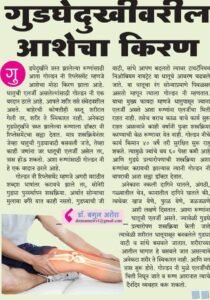
In recent years, advancements in technology have revolutionized the field of medicine, and orthopedics is no exception. Robotic-assisted surgeries have emerged as a game-changer, providing more precise and personalized treatment options for patients. One such ground breaking procedure is robotic partial knee replacement surgery. In this blog, we will delve into the details of this innovative surgical technique and explore its benefits, process, and potential impact on patients’ lives.
In recent years, advancements in technology have revolutionized the field of medicine, and orthopedics is no exception. Robotic-assisted surgeries have emerged as a game-changer, providing more precise and personalized treatment options for patients. One such ground breaking procedure is robotic partial knee replacement surgery. In this blog, we will delve into the details of this innovative surgical technique and explore its benefits, process, and potential impact on patients’ lives.
Robotic-assisted surgery combines the expertise of orthopedic surgeons with the precision and accuracy of robotic technology. It involves the use of a robotic arm, which is controlled by the surgeon, to perform the procedure. The robotic arm provides real-time feedback and assists the surgeon in planning and executing each step of the surgery with greater precision.
Personalized treatment: Robotic technology allows for a personalized surgical plan based on each patient’s unique anatomy and condition. This individualized approach results in a better fit and alignment of the prosthetic implant, leading to improved outcomes.
The minimally invasive nature of this procedure means smaller incisions, reduced tissue damage, and faster recovery time compared to traditional knee replacement surgeries. Patients experience less pain, minimal scarring, and shorter hospital stays.
Robotic guidance enables Robotic Knee Replacement Surgeon to achieve optimal positioning of the prosthetic implant, ensuring better stability, range of motion, and longevity of the implant.
Due to the minimally invasive nature of the surgery, patients can start rehabilitation and physical therapy sooner, leading to a quicker return to daily activities and improved overall quality of life.
Preoperative planning: Before the surgery, the surgeon obtains a CT scan of the patient’s knee joint, which is used to create a 3D model. The surgeon then uses specialized software to plan the procedure, mapping out the optimal implant positioning and determining the bone cuts required.
During the surgery, the surgeon uses the robotic arm to guide the cutting and shaping of the bone surfaces with utmost precision. The robotic system provides real-time feedback, ensuring the surgeon adheres to the preoperative plan.
Once the bone surfaces are prepared, the surgeon implants the prosthetic components in the knee joint. The robotic system assists in achieving accurate alignment and balance, promoting better functionality and longevity of the implant.
After the surgery, patients receive comprehensive postoperative care, including pain management, physical therapy, and follow-up visits. The recovery period varies from person to person, but with the help of robotic partial knee replacement, patients typically experience a faster and smoother recovery compared to traditional knee replacement surgeries.
There are various types of robotic knee replacement procedures available, each designed to address specific areas of the knee joint. The two main types are
This procedure focuses on the inner side of the knee joint and is commonly used to treat patients with isolated medial compartment arthritis.
This technique primarily targets the kneecap (patella) and the groove at the end of the thigh bone (femur). It is suitable for patients with patellofemoral arthritis or specific cases where the patellofemoral joint is affected.
Robotic partial knee replacement surgery represents just the tip of the iceberg when it comes to the potential of robotic technology in orthopedics. As technology continues to advance, robotic systems are likely to play an increasingly significant role in various orthopedic procedures, providing better outcomes, shorter recovery times, and improved patient satisfaction.
Robotic Partial Knee Replacement in India: The Rising Trend
Robotic partial knee replacement surgery is gaining significant momentum in India’s healthcare landscape. Several renowned hospitals and orthopedic centres across the country have adopted robotic systems to offer advanced treatment options to patients. India’s skilled orthopedic surgeons are leveraging this technology to provide precise and efficient partial knee replacements, enhancing patient outcomes and overall satisfaction.
Robotic partial knee replacement surgery is an innovative and transformative approach to treating knee osteoarthritis. With its precise and personalized nature, this procedure offers numerous benefits, including better alignment, minimal tissue damage, and faster recovery. As the field of robotics continues to evolve, we can expect even more breakthroughs in orthopedic surgery, enhancing the quality of life for countless patients worldwide.
If you are looking for Robotic Knee Replacement Surgery in Mumbai , Mumbai or India, Feel Free to Contact the Best Partial Knee Replacement Surgery Specialist . Dr Bakul Arora is one of the Best Knee Replacement Surgeon in Thane and Mumbai and he is specialised in Robot assisted partial knee replacement and Robot Assisted Total Knee Replacement Surgery.
Partial knee replacement surgery is suitable for patients who have arthritis primarily limited to one compartment of the knee joint. It is essential to undergo a thorough evaluation by an orthopedic specialist in Thane to determine if partial knee replacement is the right option for you based on your individual condition and medical history.
In partial knee replacement surgery, only the damaged part of the knee joint is replaced, preserving the healthy portions. Total knee replacement, on the other hand, involves replacing the entire knee joint. Partial knee replacement is a less invasive procedure with a shorter recovery period and potentially fewer complications. It is generally recommended for patients with isolated arthritis in one compartment of the knee.
Some of the benefits of partial knee replacement surgery include:
The recovery time can vary from patient to patient, but generally, partial knee replacement surgery has a shorter recovery period compared to total knee replacement. Most patients are able to walk with the assistance of a walker or crutches within a few days after surgery. Physical therapy and rehabilitation play a crucial role in restoring strength, flexibility, and mobility, with most patients returning to normal activities within several weeks to a few months.
While partial knee replacement surgery is generally safe, like any surgical procedure, there are potential risks and complications. These may include infection, blood clots, implant loosening, nerve or blood vessel damage, persistent pain, stiffness, or the need for additional surgery. It is important to discuss these risks with your surgeon and follow all post-operative instructions to minimize potential complications.
Partial knee replacement surgery aims to relieve pain and restore function, allowing patients to resume their normal activities with improved joint function. However, it is essential to follow your surgeon’s guidance and gradually increase activities as part of the rehabilitation process. Your surgeon will provide specific instructions on when it is safe to return to various activities, including sports and high-impact exercises.
Partial knee replacement surgery is a long-term solution for managing arthritis in the affected compartment of the knee. The longevity of the implant depends on various factors, including your age, activity level, and adherence to post-operative care. While the implant may eventually wear out over time, partial knee replacements have shown excellent long-term outcomes, providing relief from pain and improving joint function for many years.
It is normal to experience some discomfort and pain in the initial stages of recovery. However, the intensity of pain gradually decreases over time with appropriate pain management techniques prescribed by your surgeon. Pain medications, physical therapy, and following the recommended rehabilitation program will help manage any post-operative discomfort.
Previous knee surgery does not necessarily disqualify you from having a partial knee replacement. However, each case is unique, and your surgeon will evaluate your specific circumstances to determine the most appropriate treatment plan. Factors such as the type of previous surgery, the extent of damage, and the overall condition of your knee joint will be considered in making the final decision.
We are really honored to receive this and we will continue to serve the society better than ever We aim to provide the world-class Knee/Hip Replacement Surgical (Minimal Invasive Surgery) treatment to every patient suffering from knee or hip pain and at the same time make their life pain-free and happy.

Dr. Bakul Arora’s Joint Replacement Clinic is also known as “Arora Clinic” which is located at Hiranandani Meadows in Thane, within a very convenient proximity to Mumbai. Arora Clinic dedicated clinic for Knee Replacement surgery and all kinds of Orthopaedic treatments and surgeries
The Arora Clinic is one of the most advanced Orthopaedic clinic in Thane region and dedicated to providing the best, personalised healthcare with a breadth of surgical and medical expertise. Arora Clinic offers the modern surgical treatments like “Minimally Invasive Knee Replacement Surgery” which is also called as “PAIN-LESS SURGERY” for any complex knee diseases.
Dr. Bakul Arora is a Consultant Joint Replacement & Orthopaedic Surgeon is one of the leading Knee Replacement Surgeon in Thane and Mumbai with over 4000+ successfully surgeries. Dr. Bakul Arora specialises in Mini-invasive techniques which offer multiple benefits to patients. He does the surgery using Subvastus approach for Knee Replacement surgery and Direct Anterior Approach for Hip replacement Surgery . This new techniques has many advantages for patients like its pain-less , stich-less surgery, patients walks on the same day after surgery, no blood loss, faster recovery etc.


Knee replacement is required for advanced arthritis of the knee joint, producing painful limitation of movements and restriction in activities of daily living. Knee replacement as a solution should be offered when all non–surgical methods of treatment failed and painkiller medicines and injections also failed to reduce the Knee and hip pains.
Knee replacement can be total or unicondylar, depending on the number of compartments involved. Among the total knee replacement, there are two popular designs- Cruciate Retaining, and Posterior Stabilized. The decision for the design is best taken by the operating orthopedic surgeon based on the integrity of ligaments. Patella resurfacing as a routine is a debatable subject.
Yes, most knee replacement surgeries are minimally invasive, with numerous benefits to the patient, including smaller incisions, less tissue trauma, bleeding and post–operative pain, shorter hospital stays, faster recovery, and earlier return to work and activities — in weeks rather than months. Advantages of Minimally Invasive Knee Replacement Surgery. Patients Start walking in few hours of surgery. Patients start climbing the staircase from second day of his surgery. Patients Discharge with in 3 Days from the Hospital after surgery. No blood loss during the surgery, no blood Transfusion required. Less Physiotherapy.( No Physiotherapist required for home) Less Antibiotic. Stitchless Surgery. Recovery time is just two – three week.
Bilateral knee replacement in the same sitting, can be performed if both the knee joints are damaged to the same extent, however, the medical condition of the patient, and bone quality must be kept in consideration.
Surgery through Minimally Invasive technique patients start walking on the same day and staircase climbing starts from the second day of surgery. Patients can resume his work after 3 – 4 week.
The most significant risks include Infection, Deep vein thrombosis,and Aseptic loosening of implants. The risks correlate with the co-morbid medical condition, and must be discussed with the patient before surgery.
Patients normally require hospitalization for 3-4 days in single knee replacement, and up to 5-6 days in both knee replacement surgery
A single knee replacement takes approximately 90 min- 2 hours. Both knee replacement surgery takes approx 2-3 hours.
Years ago, knee replacement surgery was reserved for elderly patients due to a high complication rate and lack of implant durability. Modern techniques have allowed orthopaedic surgeons to base surgical decisions on a patient’s pain and disability, and not necessarily chronological age. Most patients who undergo knee replacement are between the ages of 50 and 80, but surgeons evaluate patients individually and primarily on their physiologic age and demands.
Patients can resume his/her light work after discharge from the hospital, no need for rest.
Patients are given epidural anesthesia for surgery, and post op pain relief. They are expected to follow instruction from physiotherapist regarding muscle training.




⇒ Wockhardt Hospital Mumbai Central, Mira road & Vashi
⇒ Apollo Spectra Hospital, Tardeo and Chembur
⇒ Cloud 9 Hospital, Malad
⇒ Criticare Hospital, Andheri
⇒ Arora Clinic, Hiranandani Meadows
⇒ Bethany Hospital, Vasant Vihar
⇒ Currae Hospital, Kapurbawdi
⇒ Horizon Hospital, Ghodbunder
⇒ Infinity Hospital, Majiwada
⇒ Lakecity Hospital, Khopat
⇒ Oscar Hospital, Majiwada
⇒ Drone Hospital, Bhiwandi
Arora Clinic, Shop No. 13, Block 2, Emerald Plaza, Hiranandani Meadows, Glady Alvares Road, Behind Standard Chartered Bank, Thane west – 400610
Contact: +91 93260 04795
Managed By Hopeland Healthcare @ All Rights Reserved 2023.
WhatsApp us